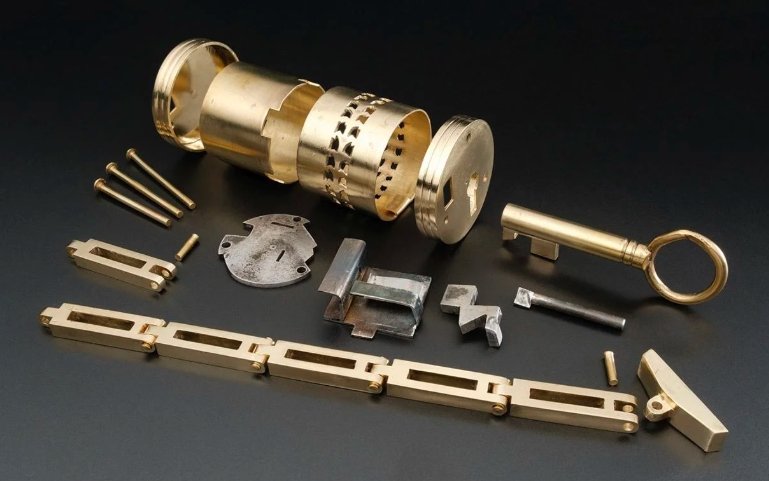A Surprising Find in Petershagen-Frille
In 2023, licensed metal detectorist Constantin Fried was surveying a field near Petershagen-Frille in North Rhine-Westphalia when he made an unexpected discovery: a small, golden lock buried just beneath the soil. Unlike typical Roman locks, which were often made from iron or bronze and much larger in size, this one was tiny, measuring just over one centimeter in diameter. It appeared to be made of gold and likely served to secure a small chest or box, possibly used for valuable items.
Fried was amazed by the find. “I could hardly believe it myself when I held the find in my hand,” he said. “Such Roman locks are usually much larger, and they tend to be made of iron or bronze.” This lock was certainly a departure from the norm, both in terms of size and material.

Analyzing the Lock’s Significance
Once the discovery was reported to the Westphalia-Lippe Regional Association (LWL), archaeologists and experts examined the lock and concluded that it was indeed a high-quality, miniature Roman box lock. Based on its shape, technical structure, and decorative style, experts believe it dates back to the third or fourth century C.E., a period during which the Roman Empire was expanding and influencing provinces far beyond its borders.
LWL Director Dr. Georg Lunemann expressed excitement about the find: “This is probably unique in Europe according to current research,” he said. The lock is believed to have been made in the provincial Roman areas, which spanned regions of modern-day Europe, and may have served as a symbol of wealth or status.
Theories on How the Lock Reached Westphalia
The lock’s journey to Westphalia remains a subject of speculation. Dr. Michael Rind, Archaeology Director at LWL, proposed that the lock may have come to the region through a local elite or soldier returning from military service in the Roman Empire’s far-reaching provinces. The lock may have been part of a small chest, which would have been affixed to keep its contents secure.
Despite the lock’s small size, its discovery is considered exceptionally rare. Rind emphasized the uniqueness of the find, noting that it was the northernmost discovery of its kind in Germany. “Was it a one-off creation, or have similar precious miniatures simply not been found before? We will continue to work on these and other questions,” he said.
Unraveling the Function of the Lock
Upon receiving the lock, researchers began to study its design more closely. Although the key and chain were missing, the lock itself consisted of two cylindrical metal sheets held together with lids on top and bottom, secured with three rivets. Initial observations showed the presence of a rusty iron core and remnants of a broken chain link, leading experts to question whether the lock had once functioned as a working mechanism.
To examine the internal structure, the team used advanced 3D neutron computed tomography (CT), a rare technique in archaeology. This imaging method allowed researchers to visualize the lock’s interior and understand its function. The CT scan revealed cross-sections of the lock’s frame, including a spring, guide rail, bolt, base plate, and pin—indicating that the lock was indeed functional when it was originally used.
“The CT examination showed that the mechanism was largely complete but damaged,” said Fried, referring to the signs of tampering likely caused by someone attempting to break or open the lock. Nonetheless, the findings allowed researchers to reconstruct the lock’s original mechanism, despite the loss of the key and chain.
Creating a Replica of the Roman Lock
Thanks to the detailed CT imagery, the researchers were able to create a larger, four-times-scale replica of the lock. This replica provided a clearer view of the lock’s intricate mechanism, making it easier to understand how it operated. The reconstruction also included a chain with six elements, based on the surviving chain link found within the lock.
Archaeologist Dr. Barbara Rüschoff-Parzinger commented on the significance of the find, saying, “The extraordinary find from Petershagen shows the high level of craftsmanship of the provincial Roman blacksmith and metalworking trade.” This discovery not only showcases Roman engineering but also underscores the cultural and economic ties between the Roman Empire and its provinces.
Looking Ahead: Implications for Further Research
This tiny golden lock is more than just a rare artifact—it offers a glimpse into the complex relationships between Rome and its provincial territories. The discovery of such a unique object could lead to further exploration of the role of local elites in Roman provincial life, as well as the material culture of the time.
For now, the lock’s discovery remains an exciting and significant contribution to the understanding of Roman craftsmanship, trade, and influence in ancient Europe.














